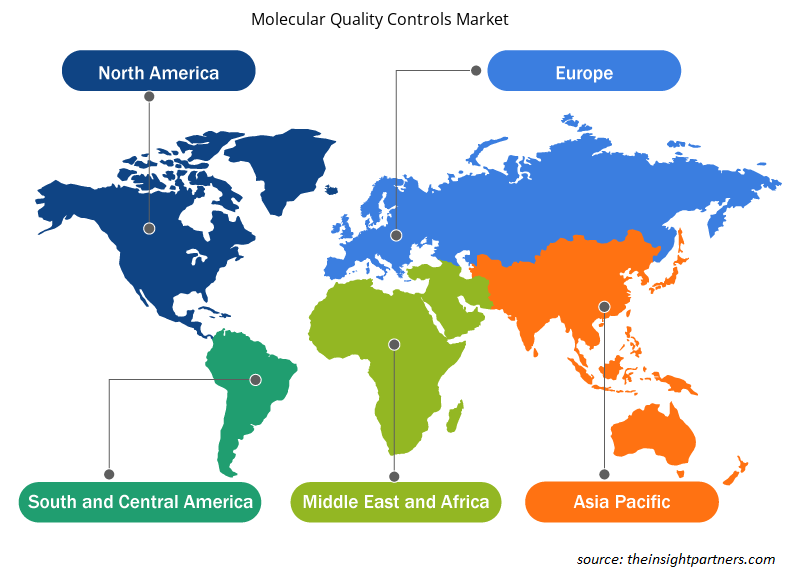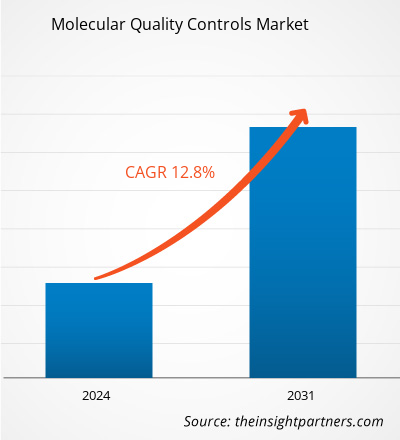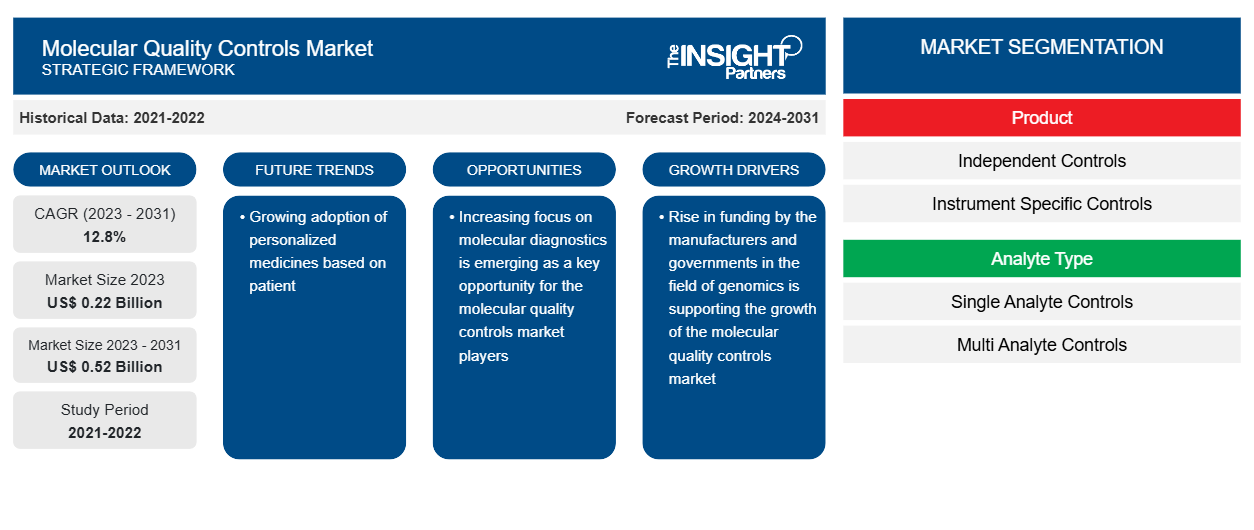Der Markt für molekulare Qualitätskontrollen soll von 0,22 Milliarden US-Dollar im Jahr 2023 auf 0,52 Milliarden US-Dollar im Jahr 2031 anwachsen. Für den Zeitraum 2023–2031 wird ein durchschnittliches jährliches Wachstum von 12,8 % erwartet. Die wachsende Nachfrage nach personalisierten Medikamenten wird wahrscheinlich weiterhin ein wichtiger Trend auf dem Markt bleiben.CAGR of 12.8% during 2023–2031. Burgeoning demand for personalized medicines will likely remain a key trend in the market.
Marktanalyse für molekulare Qualitätskontrollen
Faktoren wie steigende Mittel für die Genomik und die zunehmende Verbreitung genetischer Krankheiten treiben das Wachstum des Marktes an. Darüber hinaus bietet sich für die Akteure auf dem Markt für molekulare Qualitätskontrolle eine zunehmende Fokussierung auf die molekulare Diagnostik als wichtige Chance an.
Marktübersicht für molekulare Qualitätskontrollen
Die Genomsequenzierung war vor einigen Jahren noch auf Forschungseinrichtungen beschränkt. Inzwischen ist sie jedoch zu einer Standardtechnik in der klinischen Praxis geworden. Laut der Studie „Integrating Genomics into Healthcare“ wird der Gesundheitssektor in den nächsten Jahren voraussichtlich Genomdaten von über 60 Millionen Patienten generieren. Die zunehmende Implementierung der Genomsequenzierung in Gesundheitssystemen wird durch erhebliche staatliche Investitionen in Höhe von insgesamt über 4 Milliarden US-Dollar in mindestens 14 Ländern unterstützt. Großbritannien kündigte das weltweit größte Genomprojekt als Teil einer 200 Millionen schweren öffentlich-privaten Zusammenarbeit zwischen Wohltätigkeitsorganisationen und Pharmaunternehmen an .genomic data of over 60 million patients. The growing implementation of genomic sequencing in healthcare systems is supported by substantial government investments, totaling over US$ 4 billion in at least 14 countries. The UK announced the world’s largest genome project as a part of a 200 million public-private collaboration between charitable organizations and
Passen Sie diesen Bericht Ihren Anforderungen an
Sie erhalten kostenlos individuelle Anpassungen an jedem Bericht, einschließlich Teilen dieses Berichts oder einer Analyse auf Länderebene, eines Excel-Datenpakets sowie tolle Angebote und Rabatte für Start-ups und Universitäten.
-
Holen Sie sich die wichtigsten Markttrends aus diesem Bericht.Dieses KOSTENLOSE Beispiel umfasst eine Datenanalyse von Markttrends bis hin zu Schätzungen und Prognosen.
Markttreiber und Chancen für molekulare Qualitätskontrollen
Zunehmende Verbreitung genetischer Krankheiten
Da molekulare Qualitätskontrollen die Ergebnisinterpretation erleichtern, werden sie bei der Erkennung genetischer Störungen eingesetzt. Eine zusätzliche vollständige oder teilweise Kopie des Chromosoms 21 ist die daraus resultierende anomale Zellteilung, die die als Down-Syndrom bekannte genetische Krankheit hervorruft. Nach Angaben der US-amerikanischen Centers for Disease Control and Prevention (CDC) werden in den USA jedes Jahr etwa 6.000 Babys mit Down-Syndrom geboren. Daher nehmen die vorgeburtlichen Tests auf Down-Syndrom landesweit zu.
Zwei Gene, BRCA1 (Brustkrebsgen 1) und BRCA2 (Brustkrebsgen 2), sind bei den meisten erblichen Brustkrebsfällen mutiert. Laut der American Cancer Society sind fehlerhafte Gene, die von den Eltern an ihre Nachkommen weitergegeben werden, für 5 bis 10 % der erblichen Brustkrebsfälle verantwortlich. Genetische Tests auf erblichen Brustkrebs werden immer beliebter, da das Bewusstsein für Brustkrebs wächst.
Steigende Nutzung der Molekulardiagnostik
Molekulardiagnostikmethoden werden verwendet, um Störungen zwischen bestimmten Sequenzen in DNA oder RNA zu erkennen. Die Unregelmäßigkeiten wie Einzelnukleotidpolymorphismus (SNP), Deletionen, Umlagerungen und Insertionen führen zu verschiedenen Krankheiten – wie Infektionskrankheiten, Krebs, Viruserkrankungen und sexuell übertragbaren Krankheiten (STDs).polymorphism (SNP), deletions, rearrangements, and insertions lead to various diseases—such as infectious diseases, cancer, viral diseases, and sexually transmitted diseases (STDs).
Laut dem Bericht „Flu Facts and Statistics“ gab es zwischen 2017 und 2018 rund 31,4 Millionen ambulante Arztbesuche wegen Grippe. Außerdem wird erwähnt, dass 5 bis 20 % der US-Bevölkerung jedes Jahr an Grippe erkranken. Darüber hinaus werden laut dem National Cancer Institute im Jahr 2020 in den USA rund 1.806.590 neue Krebsfälle diagnostiziert, die Zahl der Todesfälle wird auf 606.520 geschätzt. Die Zahl der Krebspatienten wird bis 2024 voraussichtlich auf 19 Millionen steigen. Eine so hohe Prävalenz von Infektionskrankheiten und eine steigende Krebsinzidenz führen zu einer starken Nachfrage nach molekularer Diagnostik, da sie in der Lage ist, Krankheiten mit hoher Spezifität zu diagnostizieren und so den Weg für die Behandlung von Patienten mit Präzisionsmedizin ebnet.
Segmentierungsanalyse des Marktberichts zu molekularen Qualitätskontrollen
Wichtige Segmente, die zur Ableitung der Marktanalyse für molekulare Qualitätskontrollen beigetragen haben, sind Produkt, Anwendung und Endbenutzer.
- Basierend auf dem Produkt ist der Markt für molekulare Qualitätskontrollen in unabhängige Kontrollen und instrumentenspezifische Kontrollen sowie Analytentyp (Einzelanalytkontrollen und Mehrfachanalytkontrollen) segmentiert. Das Segment der unabhängigen Kontrollen hatte im Jahr 2023 den größten Marktanteil.analyte type (single analyte controls and multi analyte controls). The independent controls segment held a most significant market share in 2023.
- Basierend auf der Anwendung ist der Markt für molekulare Qualitätskontrollen nach Infektionskrankheiten, Onkologie, genetischen Tests und anderen Anwendungen segmentiert. Das Segment Infektionskrankheiten hatte im Jahr 2023 den größten Marktanteil.
- Basierend auf den Endverbrauchern ist der Markt für molekulare Qualitätskontrollen nach klinischen Laboren, Krankenhäusern, IVD-Herstellern und Auftragsforschungsinstituten, akademischen und Forschungsinstituten sowie anderen Endverbrauchern segmentiert. Das Segment der klinischen Labore hatte im Jahr 2023 den größten Marktanteil.ivd manufacturers & contract research organizations, academic & research institutes, other end users. The clinical laboratories segment held a largest market share in 2023.
Molekulare Qualitätskontrollen Marktanteilsanalyse nach Geografie
Der geografische Umfang des Marktberichts zu molekularen Qualitätskontrollen ist hauptsächlich in fünf Regionen unterteilt: Nordamerika, Asien-Pazifik, Europa, Naher Osten und Afrika sowie Süd- und Mittelamerika.
In Nordamerika sind die USA der bedeutendste Markt für molekulare Qualitätskontrolle. Zunehmende Investitionen und steigende Mittel für Hersteller sowie akademische und Forschungsinstitute zur Entwicklung von Krebsmedikamenten, zur Bekämpfung der wachsenden geriatrischen Bevölkerung, für Infektionskrankheiten und andere Therapien sind einige der wichtigsten Antriebsfaktoren.
Es wird allgemein erwartet, dass auf NGS basierende Diagnostik in Zukunft die Auswahl der Behandlung leiten wird, um die Behandlungsergebnisse der Patienten zu verbessern. Nach Angaben des National Cancer Institute werden in den Vereinigten Staaten im Jahr 2020 schätzungsweise 1.806.590 neue Krebsfälle diagnostiziert, wobei 606.520 Menschen an der Krankheit sterben werden. Ebenso wurden nach Angaben der Leukemia & Lymphoma Society (LLS) im Jahr 2020 schätzungsweise 178.520 Menschen in den Vereinigten Staaten mit Leukämie, Lymphom oder Myelom diagnostiziert. Infolgedessen würden die oben genannten Faktoren das Marktwachstum in den prognostizierten Zeiträumen ankurbeln.
Regionale Einblicke in den Markt für molekulare Qualitätskontrollen
Die regionalen Trends und Faktoren, die den Markt für molekulare Qualitätskontrollen im gesamten Prognosezeitraum beeinflussen, wurden von den Analysten von Insight Partners ausführlich erläutert. In diesem Abschnitt werden auch die Marktsegmente und die Geografie für molekulare Qualitätskontrollen in Nordamerika, Europa, im asiatisch-pazifischen Raum, im Nahen Osten und Afrika sowie in Süd- und Mittelamerika erörtert.

- Erhalten Sie regionale Daten zum Markt für molekulare Qualitätskontrollen
Umfang des Marktberichts zu molekularen Qualitätskontrollen
| Berichtsattribut | Details |
|---|---|
| Marktgröße im Jahr 2023 | 0,22 Milliarden US-Dollar |
| Marktgröße bis 2031 | 0,52 Milliarden US-Dollar |
| Globale CAGR (2023 - 2031) | 12,8 % |
| Historische Daten | 2021-2022 |
| Prognosezeitraum | 2024–2031 |
| Abgedeckte Segmente |
Nach Produkt
|
| Abgedeckte Regionen und Länder |
Nordamerika
|
| Marktführer und wichtige Unternehmensprofile |
|
Dichte der Marktteilnehmer für molekulare Qualitätskontrollen: Deren Auswirkungen auf die Geschäftsdynamik verstehen
Der Markt für molekulare Qualitätskontrollen wächst rasant, angetrieben durch die steigende Nachfrage der Endnutzer aufgrund von Faktoren wie sich entwickelnden Verbraucherpräferenzen, technologischen Fortschritten und einem größeren Bewusstsein für die Vorteile des Produkts. Mit steigender Nachfrage erweitern Unternehmen ihr Angebot, entwickeln Innovationen, um die Bedürfnisse der Verbraucher zu erfüllen, und nutzen neue Trends, was das Marktwachstum weiter ankurbelt.
Die Marktteilnehmerdichte bezieht sich auf die Verteilung der Firmen oder Unternehmen, die in einem bestimmten Markt oder einer bestimmten Branche tätig sind. Sie gibt an, wie viele Wettbewerber (Marktteilnehmer) in einem bestimmten Marktraum im Verhältnis zu seiner Größe oder seinem gesamten Marktwert präsent sind.
Die wichtigsten auf dem Markt für molekulare Qualitätskontrollen tätigen Unternehmen sind:
- THERMO FISHER SCIENTIFIC, INC. FISHER SCIENTIFIC, INC.
- Qnostics
- BIO-RAD LABORATORIES, INC.
- F. HOFFMANN LA-ROCHE LTD.HOFFMANN LA-ROCHE LTD.
- Abbott, Quidel CorporationQuidel Corporation
- Maine Molecular Controls, Inc.
Haftungsausschluss : Die oben aufgeführten Unternehmen sind nicht in einer bestimmten Reihenfolge aufgeführt.

- Überblick über die wichtigsten Akteure auf dem Markt für molekulare Qualitätskontrollen
Neuigkeiten und aktuelle Entwicklungen zum Markt für molekulare Qualitätskontrollen
Der Markt für molekulare Qualitätskontrollen wird durch die Erhebung qualitativer und quantitativer Daten aus Primär- und Sekundärforschung bewertet, die wichtige Unternehmensveröffentlichungen, Verbandsdaten und Datenbanken umfasst. Nachfolgend sind einige der Entwicklungen auf dem Markt für molekulare Qualitätskontrollen aufgeführt:
- Abbott und Personalis, Inc. haben eine Kooperationsvereinbarung zur Entwicklung und zum Vertrieb von Flüssigbiopsiekontrollen für die Forschung zur Sequenzierung der nächsten Generation (NGS) geschlossen. Ziel dieser Zusammenarbeit ist es, die Präzision und Zuverlässigkeit von Flüssigbiopsieverfahren zur Erkennung und Verfolgung von Krebs zu verbessern. (Quelle: Abbott, Unternehmenswebsite, Mai 2024)Personalis, Inc. have entered into a collaborative agreement to develop and distribute liquid biopsy controls intended for use in next-generation sequencing (NGS) research. The objective of this collaboration is to enhance the precision and dependability of liquid biopsy procedures for the detection and tracking of cancer. (Source: Abbott, Company Website, May 2024)
- Laut Qiagen sind jetzt neue QuantiTect-Viruslastkontrollen für Cytomegalovirus, Hepatitis-B-Virus (HBV) und SARS-CoV-2 verfügbar. Diese Kontrollen tragen dem steigenden Bedarf an genauer Überwachung viraler Infektionen im klinischen Umfeld Rechnung. (Quelle: Qiagen, Unternehmenswebsite, Januar 2024)QuantiTect viral load controls for cytomegalovirus, hepatitis B virus (HBV), and SARS-CoV-2 are now available, according to Qiagen. These controls address the rising requirement for accurate viral infection monitoring in clinical settings. (Source: Qiagen, Company Website, January 2024)
Marktbericht zu molekularen Qualitätskontrollen – Umfang und Ergebnisse
Der Bericht „Marktgröße und Prognose für molekulare Qualitätskontrollen (2021–2031)“ bietet eine detaillierte Analyse des Marktes, die die folgenden Bereiche abdeckt:
- Molekulare Qualitätskontrollen Marktgröße und Prognose auf globaler, regionaler und Länderebene für alle wichtigen Marktsegmente, die im Rahmen des Geltungsbereichs abgedeckt sindmarketsize and forecast at global, regional, and country levels for all the key market segments covered under the scope
- Markttrends und Marktdynamiken für molekulare Qualitätskontrollen, wie Treiber, Einschränkungen und wichtige Chancenmarkettrends as well as market dynamics such as drivers, restraints, and key opportunities
- Detaillierte PEST/Porters Five Forces- und SWOT-Analyse
- Marktanalyse für molekulare Qualitätskontrollen, die wichtige Markttrends, globale und regionale Rahmenbedingungen, wichtige Akteure, Vorschriften und aktuelle Marktentwicklungen abdeckt.marketanalysis covering key market trends, global and regional framework, major players, regulations, and recent market developments.
- Branchenlandschaft und Wettbewerbsanalyse, einschließlich Marktkonzentration, Heatmap-Analyse, prominenten Akteuren und aktuellen Entwicklungen auf dem Markt für molekulare Qualitätskontrollen
- Detaillierte Firmenprofile
- Historische Analyse (2 Jahre), Basisjahr, Prognose (7 Jahre) mit CAGR
- PEST- und SWOT-Analyse
- Marktgröße Wert/Volumen – Global, Regional, Land
- Branchen- und Wettbewerbslandschaft
- Excel-Datensatz
Aktuelle Berichte
Erfahrungsberichte
Grund zum Kauf
- Fundierte Entscheidungsfindung
- Marktdynamik verstehen
- Wettbewerbsanalyse
- Kundeneinblicke
- Marktprognosen
- Risikominimierung
- Strategische Planung
- Investitionsbegründung
- Identifizierung neuer Märkte
- Verbesserung von Marketingstrategien
- Steigerung der Betriebseffizienz
- Anpassung an regulatorische Trends























 Kostenlose Probe anfordern für - Markt für molekulare Qualitätskontrollen
Kostenlose Probe anfordern für - Markt für molekulare Qualitätskontrollen